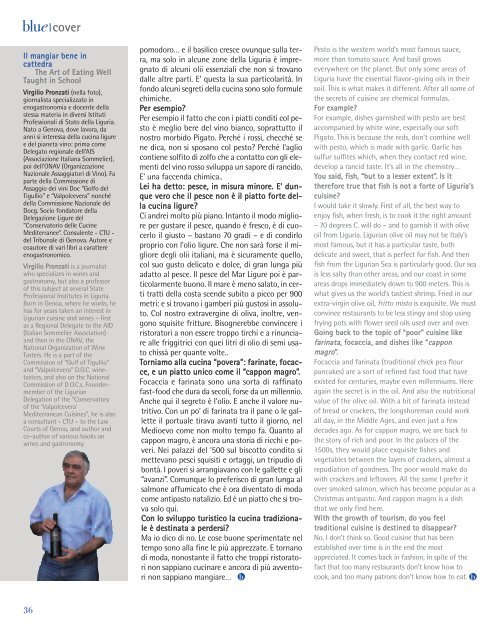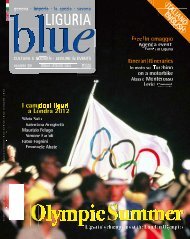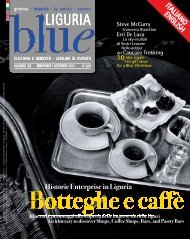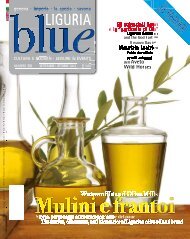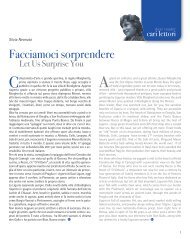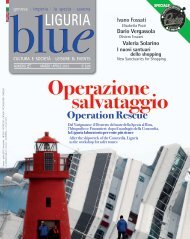cover - Blue Liguria - Sagep
cover - Blue Liguria - Sagep
cover - Blue Liguria - Sagep
Create successful ePaper yourself
Turn your PDF publications into a flip-book with our unique Google optimized e-Paper software.
lue<br />
36<br />
<strong>cover</strong><br />
Il mangiar bene in<br />
cattedra<br />
The Art of Eating Well<br />
Taught in School<br />
Virgilio Pronzati (nella foto),<br />
giornalista specializzato in<br />
enogastronomia e docente della<br />
stessa materia in diversi Istituti<br />
Professionali di Stato della <strong>Liguria</strong>.<br />
Nato a Genova, dove lavora, da<br />
anni si interessa della cucina ligure<br />
e del pianeta vino: prima come<br />
Delegato regionale dell’AIS<br />
(Associazione Italiana Sommelier),<br />
poi dell’ONAV (Organizzazione<br />
Nazionale Assaggiatori di Vino). Fa<br />
parte della Commissione di<br />
Assaggio dei vini Doc “Golfo del<br />
Tigullio” e “Valpolcevera” nonché<br />
della Commissione Nazionale dei<br />
Docg. Socio fondatore della<br />
Delegazione Ligure del<br />
“Conservatorio delle Cucine<br />
Mediterranee”. Consulente - CTU -<br />
del Tribunale di Genova. Autore e<br />
coautore di vari libri a carattere<br />
enogastronomico.<br />
Virgilio Pronzati is a journalist<br />
who specializes in wines and<br />
gastronomy, but also a professor<br />
of this subject at several State<br />
Professional Institutes in <strong>Liguria</strong>.<br />
Born in Genoa, where he works, he<br />
has for years taken an interest in<br />
<strong>Liguria</strong>n cuisine and wines – first<br />
as a Regional Delegate to the AID<br />
(Italian Sommelier Association)<br />
and then in the ONAV, the<br />
National Organization of Wine<br />
Tasters. He is a part of the<br />
Commission of “Gulf of Tigullio”<br />
and “Valpolcevera” D.O.C. winetasters,<br />
and also on the National<br />
Commission of D.O.C.s. Foundermember<br />
of the <strong>Liguria</strong>n<br />
Delegation of the “Conservatory<br />
of the ‘Valpolcevera’<br />
Mediterranean Cuisines”, he is also<br />
a consultant - CTU – to the Law<br />
Courts of Genoa, and author and<br />
co-author of various books on<br />
wines and gastronomy.<br />
pomodoro… e il basilico cresce ovunque sulla terra,<br />
ma solo in alcune zone della <strong>Liguria</strong> è impregnato<br />
di alcuni olii essenziali che non si trovano<br />
dalle altre parti. E’ questa la sua particolarità. In<br />
fondo alcuni segreti della cucina sono solo formule<br />
chimiche.<br />
Per esempio?<br />
Per esempio il fatto che con i piatti conditi col pesto<br />
è meglio bere del vino bianco, soprattutto il<br />
nostro morbido Pigato. Perché i rossi, checché se<br />
ne dica, non si sposano col pesto? Perché l’aglio<br />
contiene solfito di zolfo che a contatto con gli elementi<br />
del vino rosso sviluppa un sapore di rancido.<br />
E’ una faccenda chimica..<br />
Lei ha detto: pesce, in misura minore. E’ dunque<br />
vero che il pesce non è il piatto forte della<br />
cucina ligure?<br />
Ci andrei molto più piano. Intanto il modo migliore<br />
per gustare il pesce, quando è fresco, è di cuocerlo<br />
il giusto – bastano 70 gradi – e di condirlo<br />
proprio con l’olio ligure. Che non sarà forse il migliore<br />
degli olii italiani, ma è sicuramente quello,<br />
col suo gusto delicato e dolce, di gran lunga più<br />
adatto al pesce. Il pesce del Mar Ligure poi è particolarmente<br />
buono. Il mare è meno salato, in certi<br />
tratti della costa scende subito a picco per 900<br />
metri: e si trovano i gamberi più gustosi in assoluto.<br />
Col nostro extravergine di oliva, inoltre, vengono<br />
squisite fritture. Bisognerebbe convincere i<br />
ristoratori a non essere troppo tirchi e a rinunciare<br />
alle friggitrici con quei litri di olio di semi usato<br />
chissà per quante volte..<br />
Torniamo alla cucina “povera”: farinate, focacce,<br />
e un piatto unico come il “cappon magro”.<br />
Focaccia e farinata sono una sorta di raffinato<br />
fast-food che dura da secoli, forse da un millennio.<br />
Anche qui il segreto è l’olio. E anche il valore nutritivo.<br />
Con un po’ di farinata tra il pane o le gallette<br />
il portuale tirava avanti tutto il giorno, nel<br />
Medioevo come non molto tempo fa. Quanto al<br />
cappon magro, è ancora una storia di ricchi e poveri.<br />
Nei palazzi del ‘500 sul biscotto condito si<br />
mettevano pesci squisiti e ortaggi, un tripudio di<br />
bontà. I poveri si arrangiavano con le gallette e gli<br />
“avanzi”. Comunque lo preferisco di gran lunga al<br />
salmone affumicato che è ora diventato di moda<br />
come antipasto natalizio. Ed è un piatto che si trova<br />
solo qui.<br />
Con lo sviluppo turistico la cucina tradizionale<br />
è destinata a perdersi?<br />
Ma io dico di no. Le cose buone sperimentate nel<br />
tempo sono alla fine le più apprezzate. E tornano<br />
di moda, nonostante il fatto che troppi ristoratori<br />
non sappiano cucinare e ancora di più avventori<br />
non sappiano mangiare…<br />
Pesto is the western world’s most famous sauce,<br />
more than tomato sauce. And basil grows<br />
everywhere on the planet. But only some areas of<br />
<strong>Liguria</strong> have the essential flavor-giving oils in their<br />
soil. This is what makes it different. After all some of<br />
the secrets of cuisine are chemical formulas.<br />
For example?<br />
For example, dishes garnished with pesto are best<br />
accompanied by white wine, especially our soft<br />
Pigato. This is because the reds, don’t combine well<br />
with pesto, which is made with garlic. Garlic has<br />
sulfur sulfites which, when they contact red wine,<br />
develop a rancid taste. It’s all in the chemistry…<br />
You said, fish, “but to a lesser extent”. Is it<br />
therefore true that fish is not a forte of <strong>Liguria</strong>’s<br />
cuisine?<br />
I would take it slowly. First of all, the best way to<br />
enjoy fish, when fresh, is to cook it the right amount<br />
– 70 degrees C. will do – and to garnish it with olive<br />
oil from <strong>Liguria</strong>. <strong>Liguria</strong>n olive oil may not be Italy’s<br />
most famous, but it has a particular taste, both<br />
delicate and sweet, that is perfect for fish. And then<br />
fish from the <strong>Liguria</strong>n Sea is particularly good. Our sea<br />
is less salty than other areas, and our coast in some<br />
areas drops immediately down to 900 meters. This is<br />
what gives us the world’s tastiest shrimp. Fried in our<br />
extra-virgin olive oil, fritto misto is exquisite. We must<br />
convince restaurants to be less stingy and stop using<br />
frying pots with flower seed oils used over and over.<br />
Going back to the topic of “poor” cuisine like<br />
ffaarriinnaattaa, focaccia, and dishes like “ccaappppoonn<br />
mmaaggrroo”.<br />
Focaccia and farinata (traditional chick pea flour<br />
pancakes) are a sort of refined fast food that have<br />
existed for centuries, maybe even millenniums. Here<br />
again the secret is in the oil. And also the nutritional<br />
value of the olive oil. With a bit of farinata instead<br />
of bread or crackers, the longshoreman could work<br />
all day, in the Middle Ages, and even just a few<br />
decades ago. As for cappon magro, we are back to<br />
the story of rich and poor. In the palaces of the<br />
1500s, they would place exquisite fishes and<br />
vegetables between the layers of crackers, almost a<br />
repudiation of goodness. The poor would make do<br />
with crackers and leftovers. All the same I prefer it<br />
over smoked salmon, which has become popular as a<br />
Christmas antipasto. And cappon magro is a dish<br />
that we only find here.<br />
With the growth of tourism, do you feel<br />
traditional cuisine is destined to disappear?<br />
No, I don’t think so. Good cuisine that has been<br />
established over time is in the end the most<br />
appreciated. It comes back in fashion, in spite of the<br />
fact that too many restaurants don’t know how to<br />
cook, and too many patrons don’t know how to eat.


